Frantic strokes battering keyboards, spreadsheets cramming up the screens, screenshots getting pulled from scattered Slack threads, and last-minute emails begging for old logs flooding inboxes. That’s how audit seasons look for most teams – not a process, but a last-minute scramble that drowns everyone in chaos.
And when the audit fails, it’s rarely from a lack of effort, but mostly from a lack of organized, time-stamped, audit-grade evidence. In compliance, that’s everything.
Without evidence, contracts get lost, regulators take notice, and overnight, the company’s “strong security posture” looks less like a fortress and more like a house of cards.
Auditors care about what you can prove. And without objective, verifiable, auditable evidence, you’re just left crossing fingers and hoping to pass the audit.
In this blog, you’ll learn how to collect evidence the right way and turn audit season from a scramble into a system.
Let’s get started.
TL;DR
- Evidence is everything. Without organized, time-stamped, audit-grade proof, compliance collapses, contracts are lost, regulators press harder, and trust erodes.
- Manual collection means chasing people, battling spreadsheets, and juggling tabs. Automation flips the script with accurate, continuous, audit-ready evidence pulled straight from the source.
- Make compliance continuous. Strong evidence practices are centralized, automated, and aligned with frameworks, turning audits from seasonal scrambles into routine checks, building resilience and trust.
What Is Evidence Collection in Compliance?
Evidence collection is the systematic gathering of proof that your organization is following the rules it claims to follow, the controls are performing as expected, and the policies are being enforced without anomalies. It proves that your organization complies with the regulations and is taking adequate steps to protect customer data and its systems from unauthorized access.
In compliance, evidence is a trail of documents — digital or otherwise —showing auditors, regulators, and even customers that your security and compliance controls are written in policy docs and alive in practice.
Evidence takes many forms:
- System access logs that prove only authorized users got in
- Change management tickets that show approvals before code hits production
- Training records that confirm employees actually completed security training
- Encryption settings that demonstrate sensitive data is protected
- Vendor assessments that highlight third-party risks were reviewed
With it, compliance becomes defensible, traceable, and trustworthy.
Yet, not all evidence is created equal. Random screenshots, scattered spreadsheets, and ad-hoc logs don’t cut it. Actual compliance evidence must be organized, time-stamped, complete, and auditable.
Why is effective evidence collection so important in compliance?
Auditors can’t take vague assurances; they need to assess your compliance and security posture with hard proof – screenshots, logs, documentation, and records – that signals your compliance posture isn’t just an audit season scramble, but a disciplined operation that shows up daily.
A real audit trail proves this story, unambiguously explaining when you were compliant, when you drifted, how long issues lasted, who fixed them, and when. It helps auditors assess if you were within the threshold of compliance.
Not only that, but for auditors, evidence is necessary because each missing piece of the puzzle is a blind spot that bad actors can exploit. Let too many of them pass by, and you risk your compliance posture.
For you, effective evidence collection is an opportunity, because:
- It makes audits glide: Organized, audit-grade evidence shortens cycles and reduces findings
- Strengthens your resilience: Evidence trails reveal weak spots before they become breaches in your systems
- Wins you trust: Customers and investors gain confidence knowing compliance is backed by hard proof
- Frees up your team from reactive work: Scrambling your teams once a year leaves you rushing through control tests, patching tasks, and scrambling for evidence. This pulls them away from tasks that matter, like risk management.
Manual vs automated evidence collection
Manual evidence collection is a grind that eats away at time and resources. Teams get stuck juggling tools and tabs to dig out and record logs. They burn out battling spreadsheets – color coding, sorting, labeling – to collect evidence, policies, risks, and controls. Deadlines get missed chasing individuals and teams for screenshots, approvals, and sign-offs for evidence.
The resulting damage goes much deeper than lost time and resources. Evidence gets scattered, document versions conflict, and gaps slowly widen.
The fallout eventually brings far-reaching consequences:
1. Audits stretch out:
Incomplete or inconsistent evidence forces auditors to dig deeper. One missing log or half-baked screenshot triggers follow-up requests, scope expansion, and bigger sample sizes. What should take days drags into weeks.
2. Findings multiply
Without clear timestamps or a whole chain of custody, auditors can’t accept the proof. Each gap becomes another finding, inflating reports with issues that could’ve been avoided.
3. Teams burn out
Manual pulls and re-pulls mean long nights fixing errors and chasing missing records. By the time one audit closes, prep for the next one has already started.
4. Risk hides
Gaps in evidence usually signal gaps in control execution. If you can’t prove a control ran, chances are it didn’t — leaving risks unchecked.
Automation flips the script. Instead of chasing proof, it automatically collects it, directly from the source systems via integrations. The best part is that they make it Immutable, organized, and always audit-ready.
Here’s what automation delivers:
1. Speed
Evidence pulled in minutes, not weeks. Since the systems are connected, automation continuously scans the environment and records the evidence of compliance at set SLAs.
2. Continuity
Compliance and security drifts get caught early, before auditors or attackers do.
3. Clarity
It compiles everything into one single source of truth that auditors can trust and trace end-to-end.
4. Trust
It builds clean reports that double as customer assurance.
The lesson is simple: manual evidence turns audits into chaos, and automated evidence turns them into control.
What are the different types of compliance evidence?
Compliance evidence generally falls into two categories: documentary and experiential. Documentary evidence covers written records such as policies, logs, reports, and certifications, while experiential evidence involves direct examinations, observations, or the performance testing of controls. Together, they serve a single purpose: to prove that compliance isn’t just a matter of written promises but a set of practices carried out and verified in reality.
However, these two types of compliance evidence break into subtypes. For a successful audit, you don’t only need to collect different kinds of evidence, but you also need to know which type of evidence is used for what purpose.
Here are the different types of compliance evidence:
1. Policies and procedures
These documents set the tone for security in your company. They define what needs to be protected and how. They include all the IT procedures, HR policies, privacy policies, and more. To count as evidence, they need to align with updated regulations.
2. Records and logs
If policies show intent, logs and records show execution. These are the day-to-day artifacts like system access logs, change management tickets, training completion records, and incident reports. What makes them powerful is their time-stamped traceability.
3. Certifications and licenses
These are the external stamps of approval. ISO 27001, SOC 2, HIPAA attestations, PCI DSS certifications, and business licenses all demonstrate the commitment to security and validate compliance independently. They are essential for proving your compliance to your customers.
4. Training documentation
Training is a cornerstone of any compliance. Frameworks like ISO 27001, SOC 2, PCI-DSS, and GDPR all mandate periodic training to educate staff about compliance procedures and security. Training records that state when and how training sessions were held, training decks, and attendance records serve as evidence.
5. Risk assessments
These show how the organization looks forward, not just backward. Documenting risk assessments demonstrates due diligence — that potential vulnerabilities were identified, evaluated, and mitigation plans were created. It’s evidence of proactive compliance, not just reactive fixes.
6. Incident response records
This document details how incidents were contained, managed, and fixed once they were identified. It also documents root cause analysis, corrective actions, and lessons learned to prevent them from happening again.
7. Evidence of control performance
Control performance is one of the most direct proofs of compliance. It clearly illustrates how the security is faring against potential threats and whether policies are being enforced. This evidence has different shapes, like screenshots, access reviews, and automated monitoring reports.
Best practices for evidence collection in compliance
Collecting evidence isn’t about dumping artifacts into a folder and hoping auditors won’t dig too deep. It’s about organizing them so the files are not scattered across drives, screenshots have timestamps to prove compliance, and risks and controls have owners who can answer questions and be held accountable.
If done right, it will become embedded in your organization’s culture, turning from a reactive, audit-season scramble to a system that effortlessly proves compliance.
Here are a few best practices to do evidence collection the right way:
1. Build evidence into workflows, not audits
Collect evidence right from the source, as and when things change and update, or bake it into daily workflows. This includes ticketing systems, CI/CD pipelines, HRMS, Cloud platforms, and your team’s devices. Evidence should be a byproduct of work, not a separate task.
2. Centralize everything
Scattered evidence is lost evidence. Maintain a single, secured repository that acts as the system of record. Organize by framework, control, and owner so it’s easy to trace by policies, controls, and proofs. This way, you get a clear hierarchy of evidence that ties to policies, controls performance, and periodic timestamped proofs that they work.
3. Time-stamp your evidence
Auditors don’t trust artifacts without context. Every piece of evidence should show when it was generated, where it came from, and who owns the control. Metadata like timestamp and control-owner is as important as the document itself.
4. Automate where it counts
Manually pulling evidence and screenshotting proof of control performance is painfully slow and rife with errors. Automate recurring evidence like access logs, configuration checks, encryption settings, and more, so they’re collected consistently and in real time. Save manual effort for judgment calls and exceptions.
5. Align with standards from day one
Your evidence means nothing if they can’t prove controls and policies recommended via the framework you’re auditing for. So map your evidence to controls and policies, then tie everything to a framework like SOC 2, ISO 27001, HIPAA, or GDPR, depending on the audit.
6. Close the loop on drift
Collecting evidence isn’t just about storing it; it’s also about flagging anomalies and remediating a drifting control. As and when you identify a control drift, assign an owner, launch remediation workflows, and document performance once remediated. Capture this entire cycle to show auditors you’re not only compliant, but resilient.
7. Make it accessible but controlled
Auditors need visibility, but not at the cost of security. Use role-based access to give them what they need and nothing more. Evidence should be easy to share, but impossible to tamper with.
Collect evidence and get rid of security threats and sprinto
Collecting evidence manually is not just exhausting but prone to human errors. It means chasing teams and individuals for evidence, battling spreadsheet sprawl, and juggling multiple apps to ensure nothing slips through the cracks.
Sprinto puts all this on autopilot. By plugging straight into your devices, infrastructure, and cloud, it automates up to 90% of the evidence collection, collecting evidence right at the source and with timestamps. It automatically organizes evidence and ties it to the controls, policies, and framework you’re auditing for, so you’re always audit-ready without the scramble.
With Sprinto, you also eliminate the need to capture the same evidence for different compliance frameworks; you can just stack on new frameworks. Sprinto will automatically reuse the proof you have gathered for the newer ones, giving you a head start for your audits. This way, you can prove compliance once and reuse across SOC 2, ISO 27001, HIPAA, PCI DSS, and more.
In practice, this means:
- Do more with less. Automate up to 90% of evidence pulls. There are no screenshots and no duplicate work.
- Nail every audit. Enter audits with clean, audit-grade proof and a centralized audit hub that keeps you in sync with your auditors.
- Enforce controls automatically. Sprinto maps and tests controls continuously, catching drift before auditors or attackers do.
- Cross-map evidence. Test once to satisfy many frameworks—scale compliance without scaling headcount.
- Collaborate in real time. Manage multiple audits and sample evidence, and communicate with auditors directly on the platform.
With Sprinto, audits stop being scrambles and start being routine. Compliance becomes continuous, not seasonal. Teams stay focused on security, not screenshots. And evidence shifts from a scramble to a strategic asset.
FAQs
1. What is the role of evidence collection in GRC?
Evidence collection provides proof of compliance. An audit reviews screenshots of control performance, logs that signal policy enforcement, and documented policies that align with compliance frameworks to judge whether an organization is compliant. Without it, GRC programs would be vague and work on unverifiable claims. However, with evidence collection, organizations feel accountable and motivated to demonstrate their posture with confirmable records.
2. Who is responsible for evidence collection?
Responsibility for compliance evidence is federated across teams, process owners, and individuals in the organization. However, risk and compliance managers often shoulder the overall accountability and responsibility of the compliance posture. They usually chase teams for evidence to keep things on track and prevent compliance from drifting.
3. How does evidence collection work in regulatory compliance?
In regulatory compliance, documentation is collected to demonstrate that the organization adheres to the criteria established by a particular law or framework (e.g., SOC 2, ISO 27001, HIPAA, GDPR). This includes gathering logs, policies, training documentation, audit findings, and control performance results. Regulators and auditors subsequently examine the evidence trail to ensure compliance requirements are fulfilled and consistently upheld.
4. How do compliance platforms like Sprinto collect audit evidence?
Platforms like Sprinto automate the entire evidence collection process by integrating with systems like cloud platforms, devices, and SaaS tools. This way, evidence is collected at the source with accurate time stamps. Automated monitoring flags any compliance drifts and triggers contextual notifications to process owners for remediation. This eliminates manual effort, reduces errors, and ensures evidence is always accurate, complete, and ready for audits.
5. What’s the difference between evidence collection and evidence mapping?
Evidence collection refers to proof that a control works, a policy is enforced, and the systems are compliant. Evidence mapping involves mapping the evidence, like screenshots, logs, and documentation, to the right policy, control, and framework. Put simply, the collection answers “what happened?” while mapping answers “how does this prove compliance with SOC 2, ISO 27001, or HIPAA?” Both are necessary: collection ensures you have the raw proof, and mapping ensures that evidence satisfies the right obligations.
Srikar Sai
As a Senior Content Marketer at Sprinto, Srikar Sai turns cybersecurity chaos into clarity. He cuts through the jargon to help people grasp why security matters and how to act on it, making the complex accessible and the overwhelming actionable. He thrives where tech meets business.
Explore more
research & insights curated to help you earn a seat at the table.


















